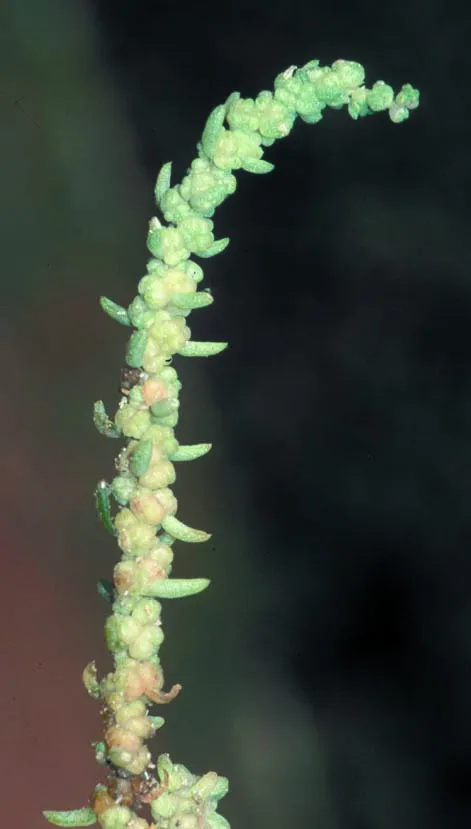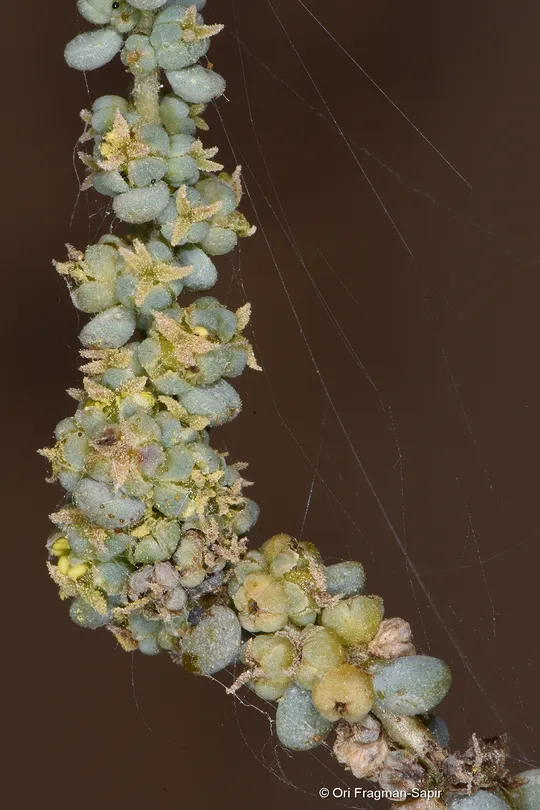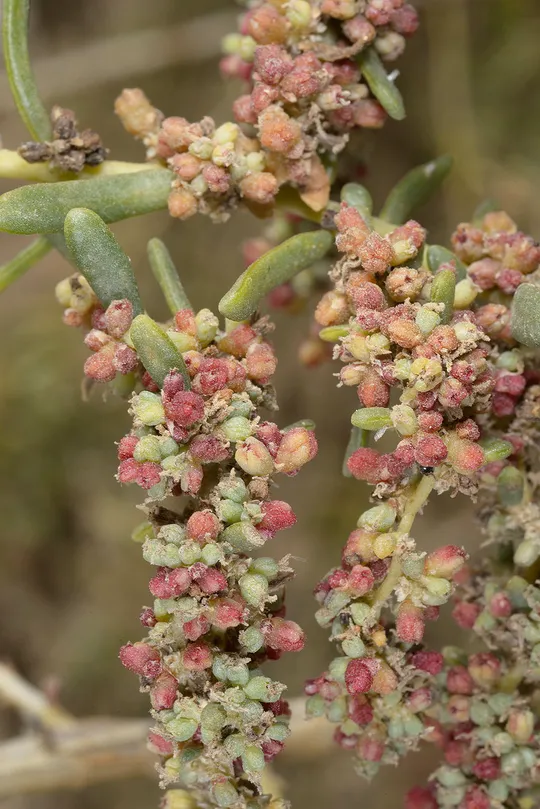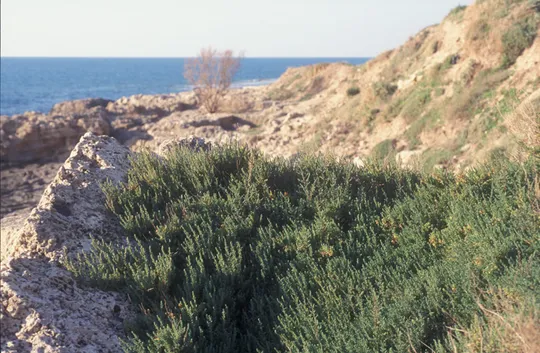Coastal Seablite
Suaeda splendens

Suaeda splendens is a tall herbaceous species up to 25-60 cm tall. The main stem is delicate, erect, bluish and branches laterally. Leaves are succulent, alternate, bluish, each one is shaped like an elongated cylinder and ends in a short bristle. The flowers are at the top of the stems, in the upper leaf axils (that serve as bracts) in groups of 3-5. Flowers are hermaphrodite and the perianth has five lobes 1.5 mm. long. S. splendens is the only annual Suaeda species in Israel (S. aegyptiaca is bi-annual and occasionally annual). It is also the only species with narrow, pointy leaves that sometimes end in a thorn-like bristle.
A very rare plant that grows in the Acre valley, on the Carmel Coast and in the Sharon. In the Acre Valley it is found today only in the Acre salt marsh. The species grows in at least six locations on the Carmel Coast in the Atlit salt flats and the Dor (Tantura) and Habonim beaches, and the populations there are relatively stable. There are also small populations on three small islands (the southern Dor, Pigeons and Tern (Jazeera al Hamman) islands) on salty calcareous sandstone. In the Sharon area, a small population grew in the Caesarea Crusader moat. Overall, there are 14 recorded sites, all close to the beach in northern Israel. Suaeda splendens grew formerly in the same regions but its distribution and the number of sites it grows in decreased. It was once common in the Acre salt marshes where it is now very rare. In the Acre Valley, it once grew in Ein Namfit, in Kfar Masaryk and in Kurdani south of Acre. In the Sharon it once grew in the vicinity of Hadera and Binyamina.
The plant grows in coastal salt marshes and on heavy saline soils on their edges, in disturbed habitats.
For the genus, see Suaeda palaestina. Suaeda splendens is a Mediterranean plant that grows on the northern shores of the Mediterranean countries: from Spain in the west through France and Italy down to Greece and Turkey in the east. Suaeda splendens belongs to ecological-systematic group of annual Suaeda, Atriplex and Salsola species that grow in disturbed saline habitats. Some of them invaded (evolutionary) and adapted themselves to roadside habitats. They exhibit characteristic rapid summer growth.
• Coastal salt marsh habitats on Israel's coastal plain are gradually disappearing due to development activity. The Kishon and Acre salt marshes represent optimal habitats whose native vegetation was severely damaged by extensive development in recent years.
• The populations are fragmented according to the fragmentation pattern of coastal salt marshes with heavy saline soils on Israel's coastal plain. The fragmentation is constantly increasing due to the disappearance of some of the populations.
• The populations in the Atlit area are apparently stable, but in the Kishon area and the Acre salt marsh (the Na’aman river mouth) the populations have been almost completely destroyed as a result of development.
• There is no information on the degree of threat in other Mediterranean countries. However, since most of the populations are small and salt marsh habitats on the Mediterranean coast are decreasing, the degree of threat is probably similar to that of Israel. The species is absent from Syria and Lebanon, and Israel has a southern fragmented population.
• Grows on three islands (southern Dor, Pigeon and Tern islands) which are nature reserves. It is also found in the Dor HaBonim coastal reserve.
The Kishon and Na’aman salt marshes, which are optimal habitats for Suaeda splendens as well as for an entire complement of other salt marsh plants which comprise the local plant community, should be protected. Drainage of the Atlit salt ponds should be prevented and the heavy, moist and saline soil around them should be protected.
Grows in all the northern Mediterranean countries from Portugal and Spain through France and Italy and eastward to Greece and Turkey. It is absent from Cyprus and Crete and has not been recorded in Lebanon and Syria. The plant’s Turkish identification is not clear and it is possible that the Turkish species is a different annual taxon that grows in the inner sub-continent.
This is the only annual species of Suaeda in Israel, and it grows only in coastal sea marshes and the saline soils bordering on them in the northern region of the coastal plain. Natural coastal salt marsh habitats are disappearing. Sites and populations are have decreased significantly and it will become extinct if the destruction of coastal salt marshes continues.
Current Occupancy Map
| 1000 squre meter pixel | 5000 squre meter pixel | 10000 squre meter pixel | |
|---|---|---|---|
| number of observations | 0 | 0 | 0 |
| in total pixels | 0 | 0 | 0 |
| Family | Chenopodiaceae |
| Classification | On the endangered species list |
| Ecosystem | Coastal area |
| Chorotype | Mediterranean |
| Conservation Site | Kishon or Na’aman Salt Marshes |
| Rarity |
1
3
6
|
|---|---|
| Vulnerability |
0
4
4
|
| Attractiveness |
0
0
4
|
| Endemism |
0
0
4
|
| Red number |
1
3.7
10
|
| Peripherality | 0 |
| IUCN category | DD EW EX LC CR EN VU NT |
| Threat Definition according to the red book | Vulnerable |
 Based on:
Based on:






